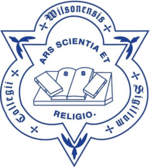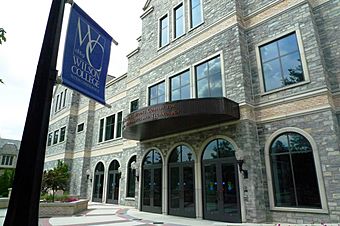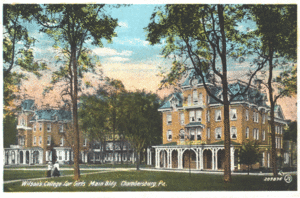Wilson College (Pennsylvania) facts for kids
 |
|
|
Former names
|
Wilson Female College (1869–1920) |
|---|---|
| Motto | Ars, Scientia, Et Religio (Arts, Sciences and Religion) |
| Type | Private college |
| Established | March 24, 1869 |
|
Religious affiliation
|
Presbyterian Church (USA) |
| Endowment | $43.4 million (2020) |
| President | Wesley R. Fugate |
|
Academic staff
|
45 full-time |
| Students | 1,620 |
| Location |
,
U.S.
39°56′53″N 77°39′11″W / 39.948°N 77.653°W |
| Campus | Nearly 300 acres (121.4 ha) |
| Colors | Silver and blue |
| Nickname | Phoenix |
| Mascot | The Phoenix |
 |
|
|
Wilson College
|
|

Wilson College Harry R. Brooks Complex
|
|
| Lua error in Module:Location_map at line 420: attempt to index field 'wikibase' (a nil value). | |
| Location | 1015 Philadelphia Ave., Chambersburg, Pennsylvania |
| Area | 55 acres (22.3 ha) |
| Built | 1870 |
| Architect | Larson, Leslie; Furness, Evans & Co., et al. |
| Architectural style | Second Empire, Colonial Revival, Late Gothic Revival |
| NRHP reference No. | 95000888 |
| Significant dates | |
| Added to NRHP | July 21, 1995 |
Wilson College is a private college in Chambersburg, Pennsylvania. It's connected to the Presbyterian Church. Two Presbyterian ministers started it in 1869. The college was named after Sarah Wilson, who gave a lot of money to help start it.
For 144 years, Wilson College was only for women. In 2013, the college decided to welcome both male and female students. Boys started living on campus in the fall of 2014.
Contents
History of Wilson College
Early Years: 1869–1900
Wilson College first opened as the "Wilson Female College" in 1869. Two pastors, Rev. Tryon Edwards and Rev. James W. Wightman, helped create it. The college officially got its start on March 24, 1869. In 1920, its name changed to "Wilson College."
It was one of the first colleges in the U.S. to accept only female students. In 1870, they said the college would help women become "leaders, not followers." The first students started classes in 1870, and the first degrees were given out in 1874.
The college was inspired by other famous women's colleges called the Seven Sisters. Sarah Wilson (1795–1871) gave money to buy the land for the campus. This is why the college is named after her.
Growth and Changes: 1900–2000
Anna Jane McKeag became Wilson's first woman president in 1911. She was followed by Ethelbert Dudley Warfield in 1915.
In 1967, the Wilson College sailing team won a big national championship. It was the first time a women's sailing event had a national competition.
The college almost closed in 1979. But students, teachers, parents, and former students worked together. They filed a lawsuit, and it helped the college stay open. Wilson College is one of the few colleges to survive a planned closing. Because of this, the college chose the Phoenix as its mascot. The Phoenix is a mythical bird that rises from ashes, symbolizing survival.
In 1982, Wilson started a program for adults who wanted to go back to school. This program is now called the Adult Degree Program. In 1996, the college was one of the first to offer housing for single mothers and their children.
Recent History: 2000–Present
The first men to attend Wilson College were at the end of World War II. There weren't enough spots at other colleges then. These men studied at Wilson for one year before moving to other schools. Later, men could earn degrees through the Adult Degree Program. However, the main undergraduate college was still only for women.
In 2013, the college's leaders decided to allow both men and women in all programs. The first male students who lived on campus started their studies in the fall of 2014.
Campus Life at Wilson College
The Wilson College campus is located near Chambersburg, Pennsylvania. It sits on both sides of the Conococheague Creek. The land was first bought from a newspaper editor named Alexander McClure. His home was burned down in 1864 during the Civil War. The home was rebuilt before being sold to the college.
What You Can Study
Wilson College offers many different study programs. Students can choose from 34 main subjects (majors) and 40 smaller subjects (minors). They can also earn master's degrees. Some of the most popular subjects include farming, animal-assisted therapy, biology, nursing, and veterinary nursing.
Sports and Athletics
Wilson College sports teams are called the Phoenix. The college is part of the NCAA Division III. This means they compete against other colleges of similar size. They rejoined the United East Conference (UEC) for the 2023–24 school year. Before that, they were in the Colonial States Athletic Conference (CSAC).
Wilson has 11 different sports teams. Men's sports include baseball, basketball, golf, soccer, and volleyball. Women's sports include basketball, field hockey, lacrosse, soccer, softball, and volleyball. They also have club sports like archery and equestrian (horseback riding). The women's equestrian team competes in many events.
Wilson College started having men's sports teams in 2014–15. This happened when the college began accepting both male and female students.
Basketball and volleyball teams play in the Gannett Memorial Field House on campus. Softball, lacrosse, and soccer teams play at fields in Kris' Meadow. Baseball plays at Henninger Field in downtown Chambersburg, which was updated in 2019.
Famous Former Students
- Betty Andujar, a politician from Texas
- Emily Bacon (1891–1972), a doctor
- Pauline Morrow Austin, a meteorologist (someone who studies weather)
- Pauline Donnan (1885–1934), an opera singer
- Martha Gandy Fales (1930–2006), an art historian
- Amy Gilbert (1895–1980), a historian
- Zack Hanle, a cooking author and journalist
- Roberta Frances Johnson (1902–1988), an American mathematician
- Katherine Laich (1910–1992), a librarian
- Kate Hevner Mueller (1898–1984), a psychologist and educator
- Irene Neal, a painter
- Mary Lawson Neff (1862–1945), a neurologist (brain doctor)
- Hannah J. Patterson (1879–1937), a suffragist (someone who fought for women's right to vote)
- Bonnie Lineweaver Paul, an attorney and politician
- Joan Risch, a homemaker who went missing in 1961
- Sally Hoyt Spofford (1914–2002), an ornithologist (someone who studies birds)
- Elizabeth Schofield (1935–2005), an archaeologist
- Rosedith Sitgreaves (1915–1992), a statistician and professor
- Delia Velculescu, an economist
- Frances Wick (1875–1941), a physicist


